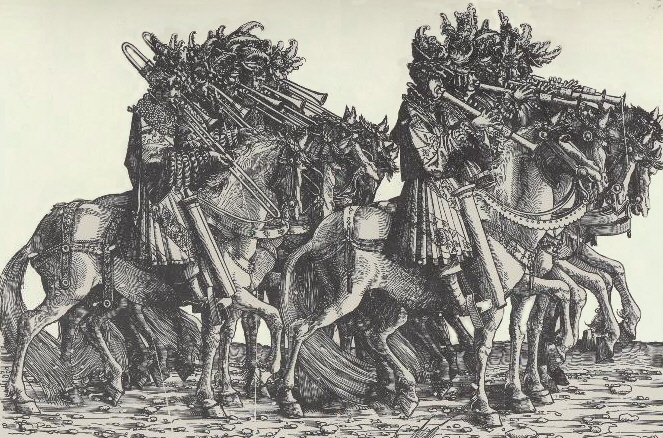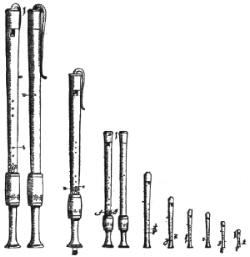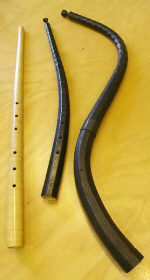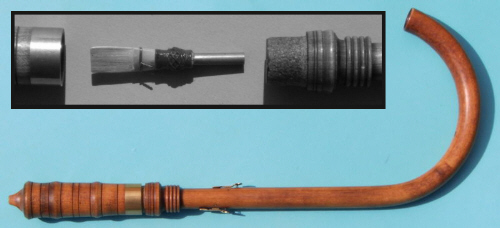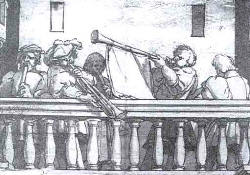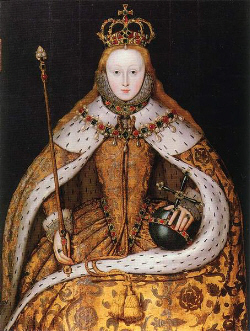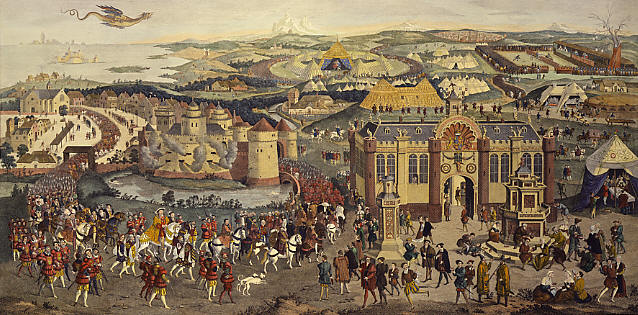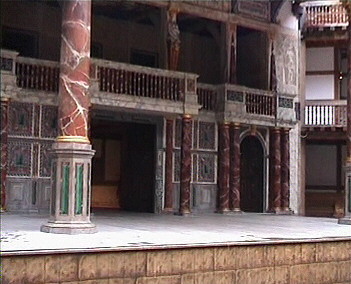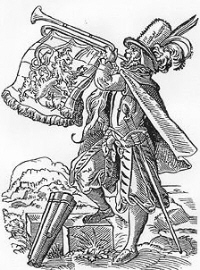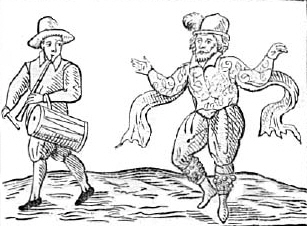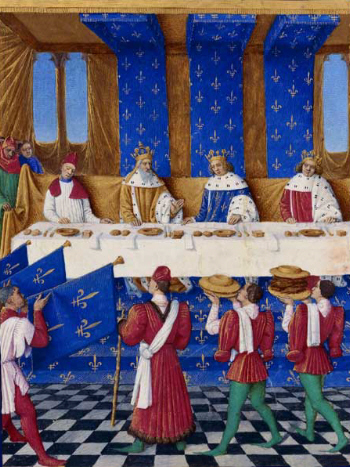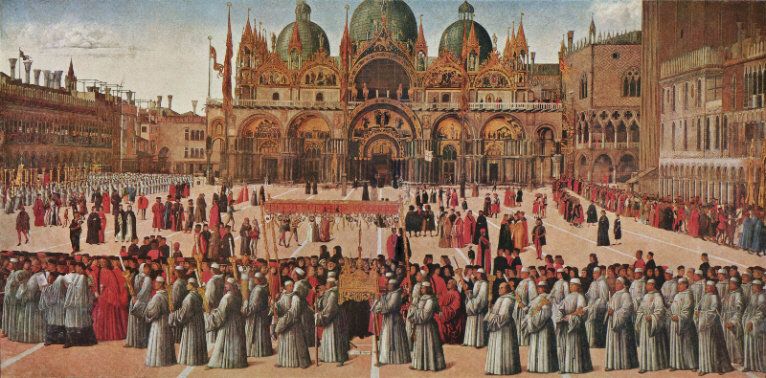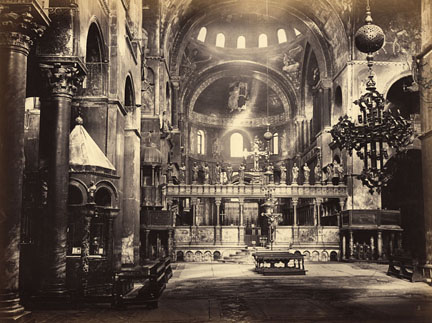2
|
||||||||||||||||||||||||||||||||||||||||||||||||||||||||||||||||||
Never before and never since has the palette of musical hues been as rich as in the sixteenth century...1 The Renaissance was an exciting age in Western Europe. As the word "renaissance" suggests, the idea of "rebirth" came from revival of interest in the art and literature of ancient Greece and Rome. During the 15th and 16th centuries scholarship was broadened to include areas of secular thought which had been neglected in earlier centuries when the church held more sway over learning. A balance arose between the secular and the sacred as new knowledge was used for the benefit of man in this world as well as for his salvation in the next.2 With the advent of the printing press in the middle of the 15th century not only were books more readily available and affordable, but printing music became a viable industry. And as art now took on a three-dimensional perspective with a true sense of depth perspective, music began to embrace the harmonic or "horizontal" aspect of composition as well as the homophonic and polyphonic texture. As the middle class of Europe became increasingly literate, interest in the arts grew also. Unlike today's culture where the majority of the world is awash in the sounds of music, this was an age where enjoying music often meant actually performing it "yourself". Referring to the above quote, the music historian Curt Sachs recognized one of the most important elements of the Renaissance period--that instrumental music had become a "force to be reckoned with". Instruments were no longer limited to simply providing accompaniment for vocal music for the elite. Evidence of the popularity of instrumental music is seen both in the interest fostered in learning to play instruments as well as the variety of instruments that were now available. To put in perspective the wealth of tone color available during this period, understand that while the oboe and bassoon families are the only representatives of double reeds in contemporary Western culture, in the Renaissance there were no fewer than ten different families of double reeds in use. RENAISSANCE WIND INSTRUMENTSIn today's contemporary society a number of the instruments used during the Renaissance seem both exotic and obscure, as many of them have fallen into disuse or have been transformed into more contemporary forms. Below is a brief description of some of the wind instruments available during the 16th century listed by generic type. Flute
Cupped-Mouthpiece Instruments
- Back to top -Double ReedsThe double reed instruments were divided into two classes. The first consisted of instruments with exposed reeds where the lips had direct contact with the reeds, such as the modern oboe and bassoon. The second class comprised instruments that were provided with a pierced cap to cover the double reed so the player could not come in direct contact with the reed itself. The cap served as a wind chamber causing the reed to vibrate similar to the reed pipes of an organ. Since the lips did not come contact with the reed, these instruments were incapable of dynamic contrast, and were limited in their pitch range due to the inability to "over-blow" the octave. Exposed reed:
Capped reeds:
- Back to top -CONSORTSAs an alternative to a cappella singing, consorts [from 1400 to 1600 musical instruments were made in families known as consorts, e.g. a set of recorders in various sizes from bass to sopranino] of up to eight different sized instruments from the same family provided musicians with instruments of similar timbre to perform multi-voiced selections. These consorts of like instruments were especially popular in the early 16th century and often used three different sizes of instruments to play four different parts -- for example, the soprano line might be played by a recorder in G while the alto and tenor lines could be covered by a tenor recorder in C, leaving the bass line for a bass recorder in F.3 It was most advantageous to have a set of horns built to exact specification by the same maker because of the enhanced intonation benefits realized. The list of instruments compiled by Michael Praetorius in the chart below illustrates how the enormous variety of wind instruments might be grouped into consorts of like timbre.
As more low-pitched instruments were introduced, the shrill, bright sound of the Medieval period was gradually replaced by a darkening of the overall ensemble sound. Due to inherent weaknesses in some sizes of instruments, substitutions were common. For instance, the smaller cornetto was often deemed more satisfactory than the alto trombone (sackbutt) as a soprano voice because the demands of the upper tessitura of the alto trombone made it less practical to play than the tenor trombone. Conversely, the trombone was more satisfactory as a bass voice because the greater distance between tone holes on larger cornettos made for increasingly difficult hand positions. The pairing of these two instruments became quite popular. Another substitution was to have a trombone or viol provide the bass line for three recorders because of the lack of projection of the bass recorder. The custom of combining instruments from different families into one ensemble was referred to as mixed or "broken" consorts -- a practice that became increasingly common. In some situations a chordal instrument such as a lute or keyboard, was used to lend support in polyphonic passages.4 Eventually, the broken consort was little more than an attempt to include alternation between winds and strings. The strings were especially popular among the wealthy and the nobility, providing yet another opportunity to separate themselves from the ordinary class of people. Between the late 16th century and the advent of the great instrument makers such as Stradivarius the string instruments began to eclipse the winds in popularity. - Back to top -Consort MusicEven as instrumental music became increasingly independent as an art form, vocal music still supplied much of the earliest repertoire for instrumentalists. Perhaps this was because playing wind instruments during the Renaissance was considered the closest sound to singing that was possible: ...a consequence of the aesthetic ideal of the Italian Renaissance, which attribute the role of voice-imitation to instruments. This ideal was so well-rooted that, as Pietro Ponzio informs us, even the instrumentalists were called "cantori". It is not to be denied that Renaissance wind instruments, not so much for their tone color as the way in which the performer breathed and produced the sound, could imitate the human voice better than could string instruments.5 The root of instrumental music was a basic, functional art form. So it is not surprising that much of the repertoire for the Renaissance wind ensemble came from dance music. This functional music eventually led to other literature that, while retaining the basic form and rhythms of the original dance, evolved into music designed exclusively for listening purposes. - Back to top -THE HOUSE OF TUDORHenry VIIIThe focal point of English history in the first half of the 16th century is Henry the VIII and the House of Tudor. His political, theological, and marital exploits are legendary. History provides us with a number of descriptions of ceremonies either held by him or in his honor. Parades, pageantry, games, and banquets all surrounded special occasions such as coronations, weddings, and visits of foreign dignitaries. For example, Henry VIII's coronation in 1509 lasted for three days, and while details of the music performances are sketchy, evidence points to three bands performing--one comprised of shalmes, one of sackbutts and shawms, and a third of trumpets. Even the celebrated Cardinal Wolsey maintained his own minstrels who played wind instruments as entertainment for events such as visiting French ambassadors and a banquet in honor of King Henry.6 - Back to top -Elizabeth IHenry VIII's daughter, Elizabeth I, also had considerable wind players at her disposal, though numbers declined somewhat towards the end of her reign. While it is difficult to obtain a precise count, records indicate that she averaged seventeen trumpets during her reign, as well as an initial consort of six trombones that later fell to three or four. She also had a consort of six flutes that declined to two full time players, and eight treble string players. Although shawms were not officially listed, they apparently were still in demand, as evidenced by the appearance of eleven players participating at Henry VIII's inauguration in 1509 and a band of six "Hoboies and Sagbuttes" playing at the funeral of Elizabeth in 1603. Records indicate that over half of Elizabeth's household musicians appear to have been foreigners. When Henry VIII created the Church of England, the inevitable closing of the Catholic monasteries also meant the elimination of a major source of music education.7 Elizabeth's inauguration was a festive occasion which included a number of pageants as well as other performances including the civic wait band of London performing in front of St. Peter's church. The coronation itself used all the court musicians led by eighteen trumpeters "blowinge at every proclamacon."8 The Field of Cloth of GoldA compelling scene is described in Hall's Chronicles of a summit between Henry VIII and Francis I of France arranged by Wolsey and designed to promote peace between the two nations. Their initial encounter is described thus:Thus vp blewe the Trumpettes, Sagbuttes, Clarions, and all oather Minstrelles on bothe sides, and the kynges descended doune towarde the bottome of the valey of Andaern, in sight of bothe the nacions and on horsebacke met and embrased the twoo kynges - each other...1 This summit, known as the Field of Cloth of Gold, came together with such pomp and circumstance that some contemporaries referred to it as the eighth wonder of the world. Despite all efforts, it accomplished very little politically. As in medieval times, musicians were an integral part of daily court life. Among their duties, they were to play for dinners and state occasions, with special responsibility for trumpeters to blow a signal as a call to dinner. Wind players played for picnics, jousts, and tournaments--events that enjoyed somewhat elaborate pageants as part of the entertainment. Masks become a fashionable court entertainment, as Elizabeth retained a penchant for dancing, even at an advanced age.9 Masks were stage productions that combined poetry, vocal and instrumental music, dancing, and acting in a lavish display of mythological and allegorical subjects. During this time trumpet playing was generally considered the exclusive domain of the monarchy. But they were also common in the military, used in such events as sounding the arrival of the queen at the celebration of the defeat of the Spanish Armada, and the arrival of the Earl of Leicester, Governor General of Her Majesty's forces in the low countries. The hierarchy of instruments went down from there. The fife and drum provided music for the regular foot company and also appeared at special ceremonies such as the funeral of Sir Philip Sidney in 1586 where three fifes and six drums covered in black cloth played very softly. This was the common instrumentation for military music in Western Europe until the Baroque period.10 - Back to top -Elizabeth's ProgressesElizabeth, ever desirous to keep her lords in hand, made periodic travels throughout the kingdom--both as a political move and to serve as a fact-finding mission. So not only were the lords being observed and evaluated, each bore the brunt of the expense of these trips as host to the queen. And these visits were quite costly, as there was the required housing for the enormous entourage with which she traveled as well as the extravagant entertainment the host was obliged to provide. One of these events or progresses, as they were called, to the Earl of Leicester at Kenilworth Castle has been recorded in vivid detail. Elisabeth enjoyed a number of days of tournaments and pageants, but perhaps the most compelling entertainment of her stay took place on Monday of the second week of her sojourn. David Whitwell describes it thus: The queen, returning from a hunt, encountered on the lake a mechanical mermaid, eighteen feet long, swimming along with Triton and his trumpet (Neptune's Balster) on its back. Following this came a mechanical dolphin, large enough to contain a complete consort hidden in its belly. Sitting on top of this twenty-four foot long dolphin was a god, Arion by most accounts, but Protheus according to Gascoigne.11 Eyewitnesses do not confirm the instruments played, since they were hidden inside the dolphin. However it is reasonable to surmise that they were wind players since the noise, muffled from its location inside the belly of the dolphin, would by necessity need to project in the best way possible. - Back to top -THE ELIZABETHAN THEATERMusic was a most important element of English theater during the Elizabethan period. Music provided color to enhance the story line, as well as entertainment between acts. Without the help of recordings it is difficult to know in great detail just how instruments were used. But with the writings of specific theater directives, some of the performance practice can be surmised with confidence. In his research into 16th century theater music, John Manifold finds no direction for an entire theater band to play all at once. Rather, such directives as music (strings, perhaps), loud music (cornetts or oboes), or hautboys, or horns within are common, or else the command for a combination of instruments might be indicated. Manifold further suggests that as few as eight to twelve players could fill out the required music: three to four viols (one doubling on lute), three to four interchangeable players for cornetts, hautboys, and recorders, and two to four for brass and drums. While directions for specific instruments were common, no indication requiring any specific piece to be played seems to exist. As a result it is uncertain to what extent original music was used, or how much original music is still available to us today, since much of it was lost. It is evident, however, that many existing tunes were used as well -- some of which may have been written initially for a specific production, only to find life in other productions as well. Among the sources of music compiled by authorities are the lists of ballads and popular songs used by Shakespeare. There was a good deal of printed music available to playwrights, vocal music especially.12 Following are some of the indications for specific instruments as found in the theater directives: Trumpet, Horn, CornettThe only brass indicated in the theater band were trumpets and horns. Since trombones (or sackbuts) were not indicated, the brass family lacked a bass voice. This, and the obvious lack of valves, set the brass apart from the other wind instruments used. In fact, trumpets were generally set apart from anything which would suggest "music," as the 1616 edition of Faustus suggests in the phrase "Trumpets cease, and Musick sounds." Horns suggest the huntsmen, couriers, and sow-gelders.13 The trumpet was the instrument used most often in the plays, taking a cue as the instrument of royalty. The military reference was secondary, referring to the ruler's title of commander-in-chief. Also entitled to this use were the field commander, admiral at sea, as well as the king's personal cavalry and household troops. Infantry music consisted of drum, fife, bagpipe, and later, the bugle. Trumpets were used in numerous plays to indicate the approach or any particular act of royalty, to announce an ambassador, herald, or envoy from a person of "trumpet rank," or to sound at tournaments or single combats. The references in plays when trumpets and horns are used take on various names: a peal is a horn call, and a tuckett is a trumpet signal. Marches were played on drums, or drum and fife, while cornetts replace fifes in the play Sophinisba, and trumpets can be found in one march in The Spanish Tragedy where the Kings of Spain and Portugal are involved. Flourishes are played at various times on trumpets, cornetts, or oboes while trumpets typically play sennets (a signal for ceremonial entrances or exits). Since trumpets were incapable of sustaining musical interest for long periods of time, their use in such activities as processionals was limited to being heard at the beginning and end of the event, with cornetts, oboes, and/or choral singing filling in the middle.14 Cornetts were used, in some instances, to imitate the presence of trumpets alluding to royalty or even to announce royalty of a more inferior rank than king. The cornett enjoyed much success during this period, being used to support church choirs, to accompany royal processions and public ceremonies, and even as an instrument for dance music.15 In incidental music, it might be coupled with organ or voices, alone, or used in dance music.16 - Back to top -Double reedsThe oboe, according to Manifold, along with the tenor oboe (English horn) and bassoon (curtal), was used more extensively and less intensively than the cornetts. The oboe was kin to the shawm or wait, and played by outdoor municipal musicians who were, as discussed earlier, also known as Waits. In a similar vein, trumpeters were called trumpets and musicians called music. Shawms are mentioned as Waits in Peele's David and Bethsabe and Jonson's The Silent Woman, and oboes in the reference "the Waits play" in various scenes of Sir Thomas Moore though they are not mentioned as a requirement in the stage directions. Oboes are specified as entertainment in Hamlet, Macbeth, Titus Andronicus, and Henry VIII, to name several. Whether this use was familiar the general populace as an every day occurrence is speculation: That hautboys were employed on special festive occasions, royal marriages, celebrations of great events and so on, is not doubted; but it is not certain whether the audiences themselves were in the habit of hiring the municipal waits when their relatives came to dinner. Still, examples given are enough to suggest that in the minds of the audience there was a strong association between the sound of hautboys and the ideas of hospitality, festivity and entertainment. - Back to top -Flute, Fife and DrumThe fife (Almain whistle), the taborer's pipe, the transverse flute (German flute), and the recorder (English flute) all found a place in the theater. Fifes were used mostly in a military context, although the fife and drum were found a carnival procession as evidenced in Shylock's warning against: The drum The pipe and tabor were used in morris dances and jigs. Flutes are specified in Gorboduc, and referred to elsewhere as still-flutes or still-pipes. Recorders seem to be used in moments involving the spiritual world. Manifold cites the following recorder "references": 1. Temple or church scenes (5) The music directives Loud Music and Soft Music were also common. One must surmise from the customs of the playwright and directives in and out of the text as to what instruments were mandated. Most likely, cornetts and oboes were the distinguishing instruments of loud music, along with the occasional addition of trumpets, despite trumpets not being customarily referred to as music. Soft music most typically was played by strings, specifically viols, or viols and lute. In between these two the consort of recorders must be fitted.18 - Back to top -FRANCEHenry VIII's contemporary, Francis I, was also a colorful figure. The 16th century was the Renaissance in France, and Francis welcomed artists to the French court. Although he was at times at war with England and Henry VIII, his greatest enemy was Charles V, King of Spain and the Holy Roman Emperor. France was almost surrounded by Charles' domain, so in order to expand French territory Francis invaded Italy. In time he not only lost his gains in Italy but also had to surrender the French province of Burgundy. Nevertheless, the sojourn in Italy had its effect on the French Renaissance both artistically and musically. Apparently Francis was ready and willing to display his artistic acquisitions, preferably with much pomp and circumstance. One account describes Francis opening curtains amidst trumpet fanfare to reveal to an audience the newly acquired paintings of the artist Raphael. Francis had musicians divided between Chambre and Écurie, the Chambre musicians being the virtuosi while the musicians of the Écurie were required to provide functional music for ceremonies, festivals, tournaments, and dance. The Chambre, as the name suggests, provided indoor entertainment, while the Écurie were notable for outdoor events. The Écurie, or school, as it translates, was the king's riding school, or stable. But within this most important element of the monarchy was control of outside events and the music that accompanied it. Among the ensembles of the Écurie was a wind band of sackbuts and shawms. The Joueurs d'instrumens de haulxbois et sacqueboutes, which in 1529 consisted of eight Italians, suggests the possibility that Francis bought an entire band on one of his trips to Italy. Thus began the foundation of wind playing which would sustain itself through the glory years of Louis XIV's Grand Hautbois.19 - Back to top -Charles VAnother concentration of winds was found at the court of Charles V, the last of the kings to follow the medieval ideal of a united Europe under Catholicism. By the age of twenty, he was King of Spain and all of its vast holdings, ruler of Germany, and Emperor-elect to the Holy Roman Empire. The enormous amount of territory for which he was responsible required extensive travel as he endeavored to hold together territory across Europe. By his own recollection he made nine trips to Germany, six to Spain, seven to Italy, four to France, and two each to England and Africa. These visits required much pomp and circumstance along with whatever entertainment was deemed necessary. A number of accounts record the use of wind bands to provide music and ceremony for such occasions. One such event took place upon his arrival to accept the title of "Charles I of Spain" in 1516. It was during these festivities that the following was described: First were twenty timpani (of the princes and great men of Castille), mounted on mules, making a great noise. Afterward came twenty-eight Spanish trumpets, followed by the twelve trumpets of Charles, all dressed in sleeveless violet tunics covered with little silver and gold letter C's sown on. Later came twelve more timpani and twelve trumpets....(When Charles presented himself in the field), first came thirty tambors on horse and two large tambors. Next came sixty more drums on foot as well as forty trumpets from Castile, Naples, and Aragon, making so much noise you could not have heard the thunder of God. Next came the twelve trumpets of Charles playing in "bon art et mode". Finally came ten German tambors on foot, and six fife players of German flutes.20 On the occasion when Pope Leo X crowned him, Charles took ten Spanish minstrels with him for the ceremony. Years later, his arrival in Barcelona in 1533 was celebrated on an enormous scale. One eyewitness reported seeing players of both loud and soft instruments including shawms, sackbuts, dulcians, trumpets, and timpani, among others. In 1540 an eyewitness reported seeing 19 or 20 trumpets as Charles entered Valenciennes.21 - Back to top -MUSIC AND THE MILITARYUnintended ConsequencesSometimes military calls did not have the desired effect on all those who encountered them.The last French king of the sixteenth century was the colorful Henry IV, formerly King of Navarre, who was fond of "the rolling of the drums and shrilling fifes."2 Early one morning, within approach of the city of Paris, the first detachment of his army played réveil with drums, trumpets, clarions, and hautbois, causing quite a stir: This caused a terrible panic; the people rose from their beds in great haste, fancying that the Huguenots had taken the city by surprise.3 It was during the Renaissance that governments began retaining standing armies, and it was in this situation that the wind band took an increasingly important role in military organization. While the military had for centuries depended on signals from winds and percussion, the demands become ever more intricate in the centuries to follow. Machiavelli, in The Art of War, recommended placing the trumpets near the general captain, with the flutes and drums carrying the sound to the further extremes where the actual battle was being fought. Through this coordinated effort he suggested the troops will be instructed to stand still, go forward, turn backward, shoot the artillery, etc. Early military signals were Italian in origin, and many of the names and signals in other languages are corruptions of the original Italian. For example, the English signal "Boot and Saddle", meaning to put on the saddle, is derived from the Italian "Butte Sella".22 Perhaps this was the call referred to by the British army's Rules and Ordynaunces for the Warre, published for the French campaign of 1544: After the watch shal be set, unto the tyme it be discharged in the mornynge, no maner of man make any shouting or blowing of hornes or whisteling or great noyse, but if it be trumpettes by a special commaundement. Euery horseman at the fyrst blaste of the trumpette shall sadle or cause to be sadled his horse, at the seconde to brydell, at the thirde to leape on his horse backe, towait on the kyng, or his lorde or capitayne.23 Apparently these calls were familiar to the general populace. - Back to top -THE BATTLEIt was during the 16th century that a new type of music descriptive of military battles emerged. Most likely Italian in origin, some of the compositional devices employed included rapid vocal interjection, imitation of fanfares with their repetition of tonic chords, and insistent rallying cries. The most famous battaglia is the four-part chanson La Guerre by Clément Janequin. The second section of this piece portrays the heat of battle using onomatopoeia to depict trumpet and drum sounds, coupled with static or repetitive harmony and energetic rhythms in a most engaging manner.24 This is the earliest example in which military calls survive in notation. In this movement, one hears not only Le boute-selle but also A l'étéendart. La Guerre went through several reprints, including one by Tilman Susato in 1545, and was the subject for several parody masses [a parody mass incorporated large portions of another work, usually a motet, into the composition of a mass], one by Janequin himself. Battle music was not limited to France. The Dutch Tielman Susato wrote a Battle Pavane, which contained elements of the fanfares found in Janequin's music. Other examples to follow were La bataglea taliana by Matthias Hermann Wereccore in 1544 and the efforts of Italians Annibale Padovano and Andrea Gabrieli who each published an Aria della battaglia in eight parts for wind instruments in 1590 and 1592 respectively. The influence of Janequin and Wereccore is evident in both these works. William Byrd's The Battell, found in My Ladye Nevells Book for keyboard, in 1591, implies trumpet fanfares most likely heard in the British military of the late 16th century.25 - Back to top -ST. MARK'S AND THE GLORY OF VENICEVenice was a unique and remarkable city in the late Renaissance. For a significant period it enjoyed fabulous wealth as a self-governing city-state. As a port city, it had served as the entrance to western Europe for much of the trade that came from the east. Wealth from this trade made possible the construction of huge, ornate government buildings. One grouping constructed on the Adriatic Sea included the palace for the doge (ruler or magistrate), the Cathedral of St. Mark, the thirty-three story bell tower or "Campanilla", and the Plaza of St. Mark's stretching beyond the bell tower. At the end of the 16th century the political and monetary glory of Venice had begun to fade, but the impact of its music was at its height. Perhaps the most memorable music had its home at the Byzantine basilica St. Mark's, which was a prototype of the Church of the Holy Apostles in Constantinople. The church is in the shape of a Greek cross, with arms of equal length. This church is somewhat unique in Western Europe because of the two choir lofts that face each other in the apses of the Choir, each loft having its own organ.26 In Venice it was customary for the merchants commanding the greatest wealth and power to be formally greeted by the Doge and his senate. A great procession would enter and march around the Plaza, with a party of musicians playing shawms and trumpets marching with the Doge. Afterward they entered the cathedral where thanks were offered to God for safe travel and the business to be transacted. It was this cultural and financial foundation that supplied the support for music at St. Mark's.27 The musicians of St. Mark's were expected to fulfill a variety of obligations both civic and religious. This, and the autonomous nature of Venice as a city-state, created a most unique climate for music performance. Whereas in Rome Palestrina answered the concerns of the Council of Trent by providing some of the most compelling a cappella music ever composed, the composers associated with St. Mark's created an equally compelling style of music using either a combination of voices and instruments or simply instruments alone. This was because St. Mark's, the private chapel of the Doge, enjoyed a larger amount of secular influence than most other churches in Italy. It was the Procurators (politicians), rather than church officials who appointed the musicians as well as some of the clerics, so it was their personal taste that determined the choices of organist, maestri, and the size of the choir and orchestra. In Venice, the grand scope of music at St. Mark's was unrivaled by any other church.28 This "golden age" of Venice's Renaissance began in 1527 with the employment of Adrian Willaert, a Franco-Flemish composer as maestro di cappella of the Cathedral and singing school at St. Mark's. Willaert was trained in the Flemish polyphonic style - a style that set the standard of composition throughout most of Western Europe. In return he took advantage of the physical uniqueness of St. Mark's and pursued the concept of double choir or "cori spezzati," which reflected the Byzantine influence on the culture of Venice.29 Willaert explored the antiphonal possibilities at his disposal by contrasting alternating choirs with full unison, as well as having one choir sing forte while the other sings piano. He also added instruments to support the choral lines -- a practice that influenced later composers at St. Mark's. Through Willaert's efforts the organist positions at St. Mark's became positions of great prestige. Two of the organists hired to fill these positions were Andrea Gabrieli (hired as second organist in 1566, moving to first organist in 1584) and his nephew Giovanni Gabrieli (hired as second organist in 1585, becoming first organist after his uncle's death in 1586). Both organists were also esteemed as composers and enjoyed connections outside of Italy, both having studied in Munich with the celebrated composer Orlando di Lasso. Andrea Gabrieli directed the focus on instrumental music at St. Mark's even further than Willaert. Through his efforts, musical timbre became a factor in composition, progressing from the practice of using two similar choirs, to the new practice of using combinations of instruments and voices, with parts written for each instrument rather than just doubling the choral line.30 Gabrieli expanded this idea by contrasting instrumental groups to the choral groups. He used instruments to cover extreme ranges, with choral groupings filling in the middle pitch range. The "coro grave" or lower range was played by instruments such as trombones, bassoons, and the lower string instruments. The upper string instruments or cornetti represented the "coro superiore" or upper voices. It was also customary for one voice to sing with the instrumental groups to retain the continuity of the text.31 Giovanni Gabrieli carried the innovations of his uncle even further. Wind instruments became a designated part of his works, especially in his later style. Specified instrumentation became more frequently required. He gained public notice when he published a volume entitled Concerto di Andrea et di Giovanni Gabrieli in 1587. In 1597 the first volume of the Sacrae Symphoniae (42 motets, twelve instrumental canzoni, three sonatas, and a Mass) was issued, followed posthumously by the second volume in 1615 (52 motets, three Magnificats, and a Mass.) - Back to top -INSTRUMENTAL FORMSComposing in the late Renaissance, Giovanni Gabrieli expanded the concept of cori spezzati to even greater lengths. He wrote for choirs of four or five instruments each (mostly trombones and cornetti) alternately playing off each other and then combining into one unit. Through this format, instruments of light tone color and high pitch could be contrasted with those of dark color and low pitch, a practice initiated by his uncle. To develop unity of form he employed means such as a da capo format, recapping a section one or more times, and/or repeating the final section. His canzonas contain a mixture of common practice while also anticipating elements associated with Baroque practice. Some elements in a typical canzona format included: 1. Having the theme start by reiterating the same pitch as it is introduced in each voice in succession (Canzona à 12, Canzon primi toni), In addition to the homophonic sections, other components of Gabrieli's style--the altered notes and cadences implying key changes (Canzon septimi toni no. 2), and his penchant for sudden dynamic contrast--are key elements of Baroque common practice to come. Indeed, the use of echo effects between loud and soft were most effective in Gabrieli's double choir format--a format which still remains the primary factor for this body of music being among the most compelling ever written. Gabrieli's sonatas are generally more homophonic than the canzonas and lack the canzona-type theme that mark Gabrieli's other works. They still make effective use of dynamic contrast replete with echo effects, as heard in the Sonata octavi toni and the more famous Sonata pian' e forte, which has long been considered the first composition of record to require specific instrumentation. - Back to top -CONCLUSIONThe music of the Gabrielis was quickly forgotten with the advent of the Baroque style initiated by the Florentine Camerata and copied by Monteverdi. Just as the music of Vivaldi has enjoyed a resurgence of popularity in the 20th century, eventually finding its rightful place out of the shadow of Bach and Handel, this repertoire of the twilight of the Renaissance now provides the contemporary listener the opportunity to experience one of the finest achievements of the Renaissance. - Back to top -
|
||||||||||||||||||||||||||||||||||||||||||||||||||||||||||||||||||
